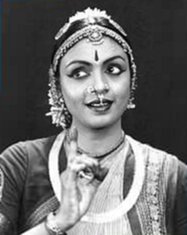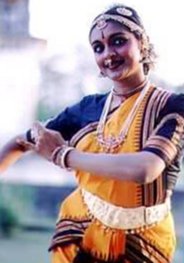
|  |

|  |
Q & A: Audience Artist Interface 21st Natyakala Conference - 2001 Chennai, India DEC 15, 2001 Priyadarshini Govind (Chennai) - "Bhava in Choreography" Jan 2002   The question and answer session after Priyadarshini Govind presented her paper turned out to be more of a common discussion among the audience present than questions directed at her about her presentation. It also turned out many more concepts of 'what is choreography?, which could be added to the already different definitions that emerged on the final day's special exercise. Shanta Dhananjayan started the question session with her query on the meaning and relevance of the word 'choreography' especially in usage attached to Indian dance. C V Chandrasekar: I think the word choreography itself is in confusion. A work in a group is accepted as choreographic work. Probably we will have to change it in any context, referring to solo choreographies and group choreographies. I am not very sure but when the solos are choreographed in a ballet, for example, when there are 2 dancers in a piece, in the western context, it's a solo composition as well as a duet composition and is accepted as choreography. The word composition is what we were all taught at the time we were learning dance, we had never heard the word 'choreography', that came when you youngsters started learning dance. Whatever it is, we should accept it in the Indian context as.... Voice: Creating a dance. C V Chandrasekar: Yes. The word 'composition' is also good enough, I think. Priya: When we choreograph, we've always been encouraged to use our imagination. A broad framework is set within which you are inspired to create. So, finally what materializes is very subjective and a personal way of interpretation. Voice: When you say 'composition', isn't it music composition? Can we say 'interpretations?' C V Chandrasekar: Yes, they are interpretations. Voice: Could there be a better word? Interpretations in choreography as an individual... (Something like...Which comes first? The chicken or the egg?) Anita: Most of us in India start the dance only after the music is set. In most instances. Sometimes, we may change a raga or a few lines. In many ways, now in India and the West, movements are created first and then the music. The system is being rebuilt in terms of dance where the movement, the dance composition, the choreographer - the person creating the dance - first begin the thought and the music comes in later. We have not been taught in the traditional context like that. It could change. But it cannot value or devalue the meaning and importance of the term 'choreography'. That's what we're trying to say. Can choreography ever be respected as an independent art form? We have to now start looking at it as a skill. Those who are involved in teaching or composing or performing are really looking at choreography as a separate skill and as it depends as Priya said, on the kind of space, kind of auditorium, kind of ambience. Va Ve Su: I encounter a similar problem when working in Tamil. For 'choreography', 10 years back, we called it 'nadana amaippu' in Tamil. Not only in English, it is difficult to use the term in Tamil too. 'Nadana amaippu' probably comprises all sides of interesting innovations, not only use of space, but also use of props, the backdrop, so many things. It's not only the individual art that holds, but she (Priya) is able to involve along with the ambience and the environment. Priyadarshini Ghosh: In my experience of working with modern dancers, the word 'choreography' doesn't matter if it's a solo or a group. What they think about is the space, how to use the space, how to communicate their ideas. (Now someone tries to remind the people about the topic which was supposed to be under discussion) Voice: We must remember that 'Bhava in choreography' is the topic and that was what was spoken about!! (Despite the reminder..... read on......)!!!!!!!! Malathi Iyengar: I once saw a performance by my colleague Ramya in Los Angeles. She looked very nice, had a microphone on attached to her costume and when each line of a Pallavi was depicted, in 10 to 15 different ways, each time she talked it too. Even a lot of Indians do not understand what in effect is going on, the whole colorful imagery that anyone is trying to create. That's also choreography. A choreography has to be thought of as a whole. It's the artistic direction of music, composition, sets, props, lights and color, not just depicting a Pallavi word to word; it's the wholesome approach. In the West, for years they have created choreography without music, it's nothing new for them. But we have been endowed with a history of over 5000 years. It's a shame not to be able to use so much of sahitya and lyrics and that's why we have this richness. (The convener takes a firmer stand.) Anita: May I remind people to please keep your questions short and pertinent to the performer. Sangeeta Isvaran: I just want to make a point here. Shanta akka was correct in questioning. What do you do if the word choreography comes from the concept of thinking? Priya: She's right. What we have done is abhinaya. To choreograph is not a physical movement but a mental and spiritual movement, thoughts that arise in us when we wrote a text and how we choreograph these thoughts, how we bring them out, what we do with them. So we are actually talking in terms of a group, not a physical group, but a mental group, a spiritual group, an emotional group of thoughts, of power, how we bring that out. So the term choreography is relevant to the setting up of an abhinaya piece as harbinger of choreography. Dhananjayan: You touched on the particulars of mudras which I want to discuss with you. Is it a fashion not to hold mudras properly? Priya: I didn't say that. Dhananjayan: Very clearly Natya Shastra says, without hastas there is no abhinaya. Without holding mudras properly, you do abhinaya, that's a different thing. You said abhinaya can be done and expressed without holding mudras properly and precisely, so please explain. Priya: I didn't mean that you shouldn't show the hastas properly in abhinaya. I particularly apologise for that wasn't the point. I merely said hastas follow bhava and do not exist on their own. My interest is not in hasta, it's on bhava and hastas promote the message that bhava gives. Dhananjayan: You'll hold the hastas properly? Priya: Yes.. Voice: I ask this as a layman. What the nattuvanars have been doing all these years when they created dance programmes..are they not choreography? Dhananjayan: Our nattuvanars never did choreography. The choreography came into being only probably with the introduction of Uday Shankar and later on taken up by Rukmini Devi. So the old nattuvanars never had an inch of an idea about choreography. They just composed, just interpreted hasta abhinayam, pada abhinayam and things like that. They never had any idea about choreography. Voice: What would you call it then? Dhananjayan: Perhaps you could call it nadana amaippu. We never knew the word choreography. Voice: You use the word choreography as creating dance, that is being done for centuries... Dhananjayan: It is a new term. We are all reading everything in English so we use that term. Kalanidhi Narayanan: I have never used the word choreography when teaching abhinaya and I always tell my girls, "don't say choreography". We are not using the right word as it should be. We are not using props or anything. We are just doing what we feel. So, I don't call it choreography. In fact, since Anita gave her the topic 'Choreography in Abhinaya', there was no other way to do it. This was the only way. V. A. K. Ranga Rao: Choreography is everything that happens on stage as intended by the dancer. If Isadora Duncan arranges a fan and makes her hair blow on her face, that is choreography. If the dancer asks the singer to sing loudly or softly and matches her movements to the loudness or softness, that is choreography. If she arranges the fall of the curtain slowly or abruptly, that is choreography. Everything that happens on stage at the instance of the dancer is choreography. Dhananjayan: That is just a new interpretation to the word. C V Chandrasekar: How much importance do you give for bhava of the entire body, angika abhinaya? Priya: The emotion that's felt in the mind is not just expressed in the eyes or face but in every part of the body. We express certain pieces of dance using less of the rest of the body, and more of eye and facial expression. Certain pieces involve using lot of angika, of course the eyes and facial expressions are never excluded. I'm just talking about the level of usage. Q & A: Audience Artist Interface 21st Natyakala Conference - 2001 |